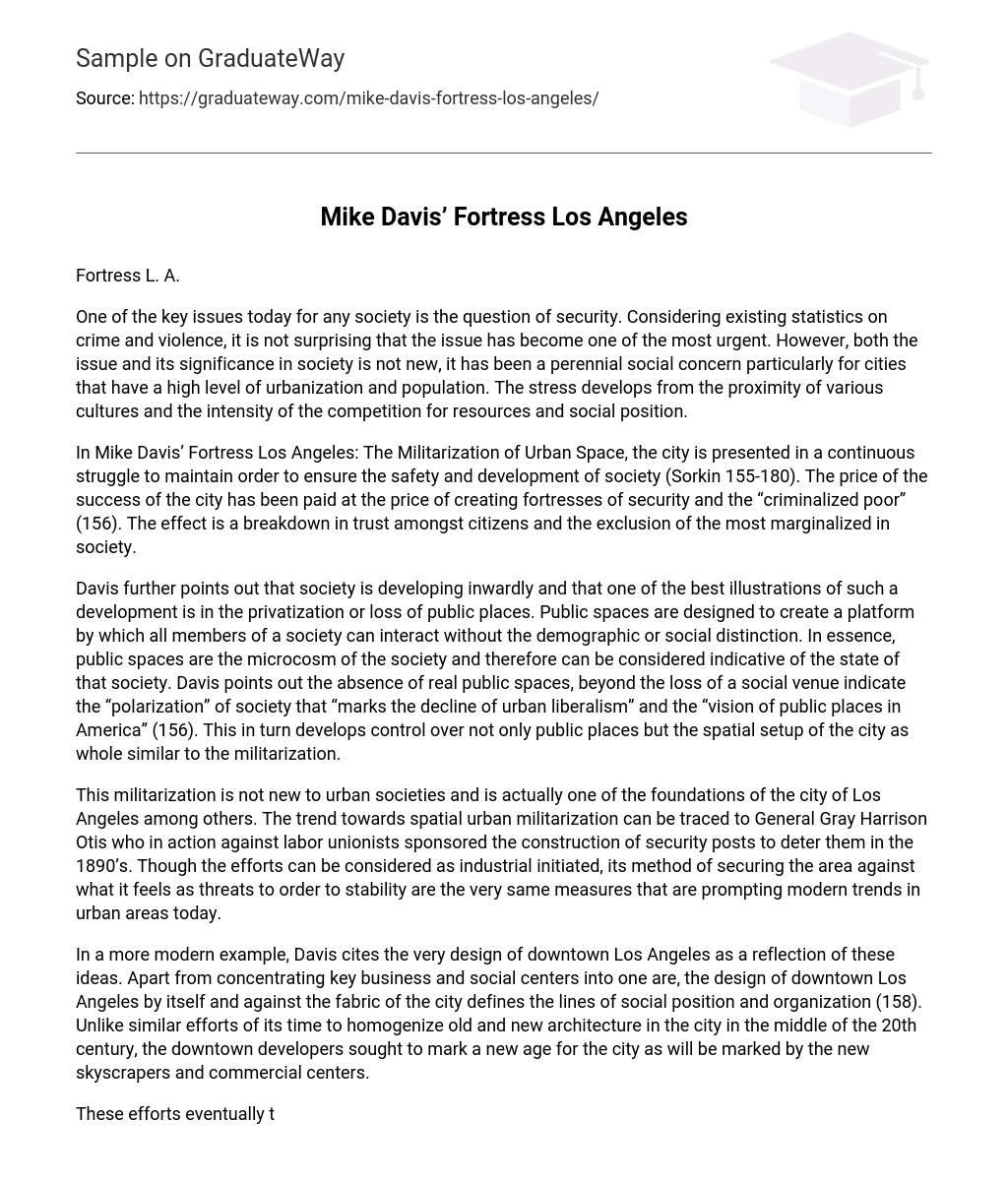Fortress L. A.
One of the key issues today for any society is the question of security. Considering existing statistics on crime and violence, it is not surprising that the issue has become one of the most urgent. However, both the issue and its significance in society is not new, it has been a perennial social concern particularly for cities that have a high level of urbanization and population. The stress develops from the proximity of various cultures and the intensity of the competition for resources and social position.
In Mike Davis’ Fortress Los Angeles: The Militarization of Urban Space, the city is presented in a continuous struggle to maintain order to ensure the safety and development of society (Sorkin 155-180). The price of the success of the city has been paid at the price of creating fortresses of security and the “criminalized poor” (156). The effect is a breakdown in trust amongst citizens and the exclusion of the most marginalized in society.
Davis further points out that society is developing inwardly and that one of the best illustrations of such a development is in the privatization or loss of public places. Public spaces are designed to create a platform by which all members of a society can interact without the demographic or social distinction. In essence, public spaces are the microcosm of the society and therefore can be considered indicative of the state of that society. Davis points out the absence of real public spaces, beyond the loss of a social venue indicate the “polarization” of society that “marks the decline of urban liberalism” and the “vision of public places in America” (156). This in turn develops control over not only public places but the spatial setup of the city as whole similar to the militarization.
This militarization is not new to urban societies and is actually one of the foundations of the city of Los Angeles among others. The trend towards spatial urban militarization can be traced to General Gray Harrison Otis who in action against labor unionists sponsored the construction of security posts to deter them in the 1890’s. Though the efforts can be considered as industrial initiated, its method of securing the area against what it feels as threats to order to stability are the very same measures that are prompting modern trends in urban areas today.
In a more modern example, Davis cites the very design of downtown Los Angeles as a reflection of these ideas. Apart from concentrating key business and social centers into one are, the design of downtown Los Angeles by itself and against the fabric of the city defines the lines of social position and organization (158). Unlike similar efforts of its time to homogenize old and new architecture in the city in the middle of the 20th century, the downtown developers sought to mark a new age for the city as will be marked by the new skyscrapers and commercial centers.
These efforts eventually translated to the organization of key areas of the city reflecting social and cultural divisions. Davies points out that the development of such a scenario was both a voluntary and consequential development. As the city developed its new commercial and business centers, many of original residences had to change to accommodate the new construction. Many of the companies building the new buildings may have offered new housing programs and thus though many of the old communities may have stayed together, there would have naturally new challenges in the changed locations of residences like in transportation, labor or schooling (158-160). At the same time, developers had to ensure that the surrounding areas fulfilled the image they wanted to be reflected on their projects and this would require redevelopment of the surrounding areas and likely more relocation or social adjustments (162-163).
All these issues raise social issues: conflicts in the new environments, redefining social and political order, exposure to cultural and social stress as well as the creation of the feeling of being disenfranchised or sacrificed for the sake of development. This ultimately then has contribute to the deterioration of social order and thus even greater efforts to regulate the city in an effort to enforce order and security (160-167). The ultimate result: militarization of urban areas.
The militarization of urban spaces as defined by Davis can be to the benefit and limitation of society (155). In Mike Colias article regarding the Chicago Police’s installation of cameras to monitor criminal activities, he points out that citizens are divided regarding the issue primarily because of the issue of privacy and public safety. Correlation the concerns raised to Davis study of Los Angeles it can be seen that in these issues, city development and crime monitoring, that efforts both defeat the core of the definition of public places as social constructs. Both efforts sought to design the nature of the urban areas that they are addressing. In Chicago, the greater regulation or control given to the police by the cameras has significantly deterred crime and the apprehension of offenders but this undoubtedly has come at the price of sacrificing the idea of public space and urban liberalism. However, it is just as easily as realizable that without the control of the public spaces in either scenarios, downtown Los Angeles would not have achieved its prestige and neither will the police be able to rehabilitate the areas of Chicago that have been the most plagued by crime.
Works Cited
Colias, Mike. “Chicago Police’s Crime-Fighting Cameras Divide Neighbors”. Associated Press, 2004
Davis, Mike. “Fortress Los Angeles: The Militarization of Urban Space” in: Michael Sorkin (Ed.) Variations on a Theme Park. New York: Hill and Wang, 1992





